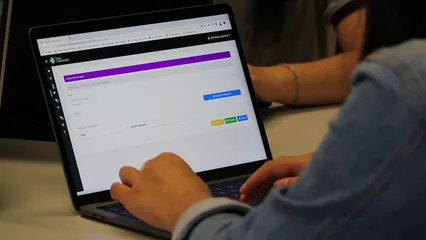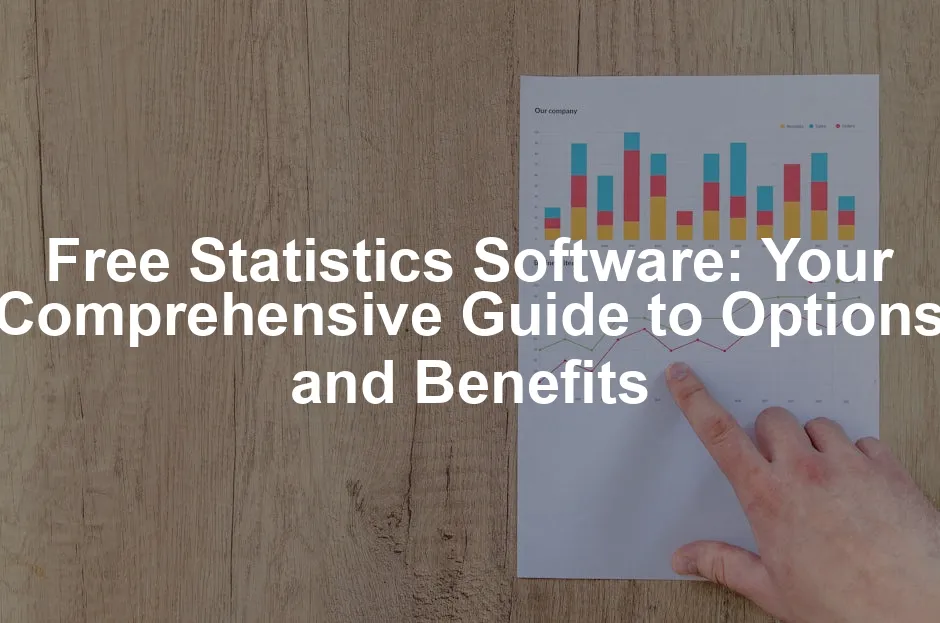Introduction
Free statistics software plays a vital role in data analysis. It allows users to perform complex analyses without financial burden. As data-driven decisions become crucial in various fields, the demand for accessible tools is increasing. This guide will highlight popular free statistical software options, their features, and tips for effective usage.
Summary and Overview
Free statistics software refers to tools that enable statistical analysis without cost. Unlike paid options, these programs often provide essential functionalities suitable for various users. Statistics is key in making informed decisions across industries like healthcare, finance, and education. Using free software offers many benefits: it’s cost-effective, accessible, and often backed by strong community support. You can find various types of free statistical software available, including open-source programs like R and Python, as well as web-based applications like Google Sheets for Beginners. Each type has unique features and advantages tailored for different analysis needs. For more insights, check out tips for effective data analysis in economics and statistics.

Understanding effective data analysis is crucial in leveraging free statistics software. Explore more about effective data analysis techniques.
Types of Free Statistics Software
Open-Source Software
Open-source software is a type of free software where the source code is available for modification. This allows users to customize the software to meet their specific needs. Popular open-source options include R for Data Science, Python Crash Course, and JASP, each offering distinct features and advantages.
R is renowned for its vast array of statistical techniques and packages. It’s powerful for complex data manipulation and analysis, making it a favorite among statisticians and data scientists. However, it does require programming knowledge, which might be a barrier for beginners. For a comprehensive guide on R, you can check the AP statistics formula sheet.

R is a powerful tool for statistical analysis. Learn more about R and its capabilities.
Python, while primarily a general-purpose programming language, has libraries like Pandas and SciPy that make it excellent for statistical analysis. Its versatility also allows users to integrate statistical analysis with web applications and data visualization. For an introduction to statistical learning with Python, visit this resource.

Python is a versatile language for statistical analysis. Discover more about using Python for statistical learning.
JASP provides a more user-friendly interface, focusing on ease of use while maintaining strong statistical capabilities. It supports both frequentist and Bayesian analyses, making it suitable for various research needs. The software also has a supportive community, offering numerous resources and forums for users to seek help.
These open-source tools often come with extensive community support. Users can find tutorials, forums, and documentation that help in mastering complex statistical methods. Engaging with the community not only enhances knowledge but also fosters collaboration among users.

Web-Based Software
Web-based statistical software has gained popularity for several reasons. First, it requires no installation, making it accessible from any device with an internet connection. This convenience is a game-changer for those who need to analyze data on the go. You simply open your web browser, and you’re ready to start your analysis.
Two standout examples of web-based software are DATAtab and Google Sheets. DATAtab is designed for user-friendliness, allowing you to execute statistical analyses easily. It offers features such as t-tests, ANOVAs, and regression analyses, all performed directly in your browser. You can input data through simple copy and paste, making it straightforward for users at all levels.
Google Sheets, while primarily a spreadsheet application, provides a range of statistical functions. It supports basic statistics and allows you to visualize data through charts and graphs. The collaborative features enable multiple users to work on the same document simultaneously, making it perfect for team projects. Plus, if you want to master it, check out The Complete Guide to Google Sheets.

Both software options prioritize ease of use, with intuitive interfaces that cater to beginners and experienced users alike. The ability to access your work from anywhere adds an extra layer of convenience, making web-based statistical software a strong choice for many.
Desktop Software
Desktop statistical software offers robust features that cater to a wide range of analytical needs. These tools typically require installation on your computer, which can provide enhanced performance and functionality compared to their web-based counterparts.
Jamovi and PSPP are two popular desktop options. Jamovi is built on the R programming language, offering a clean, user-friendly interface. It supports various analyses, including t-tests and regression, while providing access to R’s extensive capabilities. The software is available for Windows, Mac, and Linux, ensuring compatibility across different systems.
PSPP is a free alternative to SPSS, designed for those familiar with SPSS’s interface. It allows users to perform many of the same analyses without the associated costs. PSPP is also compatible with Windows, Mac, and Linux, making it accessible for a wide audience.
Installation requirements vary, but most desktop software needs a few gigabytes of free disk space. Ensuring your system meets these requirements will help avoid performance issues. Desktop software often excels in handling larger datasets and offers additional statistical methods, making it a solid choice for serious data analysts.

Key Features to Look for in Free Statistics Software
User Interface
An intuitive user interface is crucial for both beginners and advanced users. It can significantly enhance the experience of using statistical software. A well-designed interface allows users to navigate easily and find the tools they need, reducing frustration and increasing productivity.
When comparing popular software options, you’ll notice varying levels of complexity. For instance, Jamovi‘s interface is reminiscent of a spreadsheet, making it approachable for users familiar with Excel. In contrast, R may appear daunting at first due to its command-line interface, which can be less intuitive for newcomers.
Easy access to tutorials and support can also enhance usability. Software with a clear layout and helpful resources fosters a better learning environment. Consequently, whether you’re a novice or an expert, choosing software with a user-friendly interface can make a significant difference in your analysis journey.

Statistical Methods Supported
Free statistics software provides a variety of essential statistical methods. Common methods include t-tests, ANOVA, regression analysis, and correlation analysis. Each of these methods serves a unique purpose in data analysis. For instance, t-tests compare means between two groups, while ANOVA examines differences among three or more groups. To gain a deeper understanding of regression analysis, you can visit this comprehensive guide.

Understanding various statistical methods is crucial for data analysis. Learn more about regression analysis and its applications.
Having access to a wide array of statistical methods is crucial. It allows users to conduct comprehensive analyses tailored to their specific research questions. Whether you’re evaluating the effectiveness of a new drug or analyzing customer satisfaction data, the right statistical methods can provide valuable insights. With free software, you can perform complex analyses without the financial burden, making it easier to draw informed conclusions from your data.
Data Visualization Capabilities
Data visualization is a key aspect of statistical analysis. It helps transform complex data into understandable graphics, making insights more accessible. Clear visuals can often reveal trends and patterns that raw data cannot.
Several free software options excel in data visualization. For example, Plotly offers interactive graphs that can be shared online, enhancing comprehension and engagement. Desmos, a browser-based graphing calculator, allows users to create stunning visuals quickly and intuitively. These tools enable users to present their findings compellingly, which is vital for effective communication in research and business. Ultimately, strong data visualization capabilities can significantly enhance the impact of your statistical analyses.

Getting Started with Free Statistics Software
Installation and Setup
Getting started with free statistics software is generally straightforward. First, identify the software that best fits your needs. Popular options include R, Jamovi, and JASP. Visit their official websites to download the installation files.
For Windows users, follow these steps:
- Download the installer from the software’s website.
- Open the installer and follow the on-screen instructions.
- Choose your installation preferences, such as the installation path.
For Mac users, downloading is similar. Just ensure you select the correct version for your operating system. After downloading, drag the application to your Applications folder.
Linux users may need to use package managers like APT or Snap for installation. Check the software documentation for specific commands.
During installation, you might encounter issues like compatibility warnings. If the software fails to install, ensure your system meets the required specifications, such as RAM and disk space.
If you experience installation hurdles, consult the software’s user forums or help sections. These resources can provide troubleshooting tips and advice from fellow users.
Once installed, familiarize yourself with the software interface. Most programs offer tutorials or user guides to help you get started. Engaging with these resources will enhance your understanding and confidence in using the software effectively.

Learning Resources
Learning how to use free statistics software can be exciting and rewarding. Thankfully, there are numerous resources available to help you get started. One popular platform is Coursera, which offers courses that cover the basics of statistical analysis and software like R and Python. These courses are often designed by top universities and can be a great way to gain structured knowledge.
YouTube is another fantastic resource. Many content creators provide tutorials that guide you through various statistical methods and software functionalities. You can find everything from beginner’s guides to advanced techniques. Just search for the software you’re interested in, and you’ll likely discover a wealth of helpful videos.
Community forums are also invaluable. Websites like Stack Overflow and Reddit have dedicated sections for statistical software discussions. Here, you can ask questions, share insights, and learn from experienced users. Engaging with these communities can enhance your learning experience and provide answers to specific challenges you might face.
Additionally, each software package often has its own official documentation and user guides. For example, Learning Statistics with R has comprehensive online manuals that cover everything from installation to advanced statistical techniques. JASP and Jamovi also offer user-friendly guides and FAQs that can help you navigate their interfaces effectively.
By utilizing these resources, you can build a solid foundation in using free statistics software. Whether you prefer structured courses or self-paced tutorials, there’s something for everyone to learn and grow in the world of statistical analysis.

Limitations of Free Statistics Software
While free statistics software offers many benefits, it also has some limitations. One common drawback is the level of support available. Many free programs have limited customer service compared to their paid counterparts. If you encounter issues, finding help can be more challenging.
Another potential hurdle is the learning curve. Some software, like R, is powerful but requires programming knowledge. For beginners, this can feel overwhelming. Although there are resources available, the initial complexity may discourage some users from fully engaging with the software.
Compatibility issues can also arise. Certain free programs may not work seamlessly with all operating systems or hardware configurations. If you’re using specialized tools or systems, it’s essential to ensure compatibility before committing to a specific software.
Additionally, while many free options provide essential statistical functions, they might lack advanced features found in commercial software. Users seeking complex analyses or specific statistical tests may find the free versions insufficient for their needs.
Finally, while community support is a great resource, it may not always be reliable. Information can vary in quality, and users may need to sift through answers to find what’s most applicable to their situation. Recognizing and understanding these limitations can help you make informed decisions about your statistical software choices.

Conclusion
Using free statistics software is essential for anyone involved in data analysis. It offers numerous benefits, such as cost-effectiveness and accessibility, allowing users to perform complex analyses without spending money. By trying different software options, you can find the one that suits your needs best. The growing community around these tools provides ample resources for support and learning. Engaging with tutorials, forums, and user groups can enhance your understanding and help you become proficient. So, don’t hesitate! Explore the various free statistics software available and discover how they can elevate your analytical skills.
FAQs
What is free statistics software?
Free statistics software refers to tools that allow for statistical analysis without any cost. Unlike paid options, these programs typically have fewer features but can still perform essential functionalities needed for data analysis.
Is free statistics software suitable for professional use?
Yes, free statistics software can be reliable for professional applications. Many of these tools offer robust features and are widely used in various industries, proving their capabilities in handling real-world data analyses.
How do I choose the right free statistics software for my needs?
To choose the right software, consider factors like ease of use, statistical methods supported, data visualization capabilities, and community support. Determine what specific analyses you need to perform and select software that meets those requirements.
Are there any limitations in using free statistics software?
Common limitations include less comprehensive customer support and fewer advanced features compared to paid software. Some options may also require programming knowledge, which can pose a challenge for beginners.
Where can I find tutorials for free statistics software?
You can find tutorials on platforms like Coursera and YouTube, where many content creators offer detailed guides. Additionally, software-specific forums and official documentation provide valuable learning resources.
Can I use free statistics software for commercial purposes?
Most free software comes with specific licensing agreements. It’s essential to review the terms to ensure that your intended use, including commercial applications, complies with the software’s licensing.
How does free software compare to paid alternatives?
Free software often lacks some advanced features found in paid versions, but it provides a great starting point for many users. The main advantages of free software include cost savings and community support, while paid software typically offers more extensive customer service and advanced functionalities.
Please let us know what you think about our content by leaving a comment down below!
Thank you for reading till here 🙂
All images from Pexels




